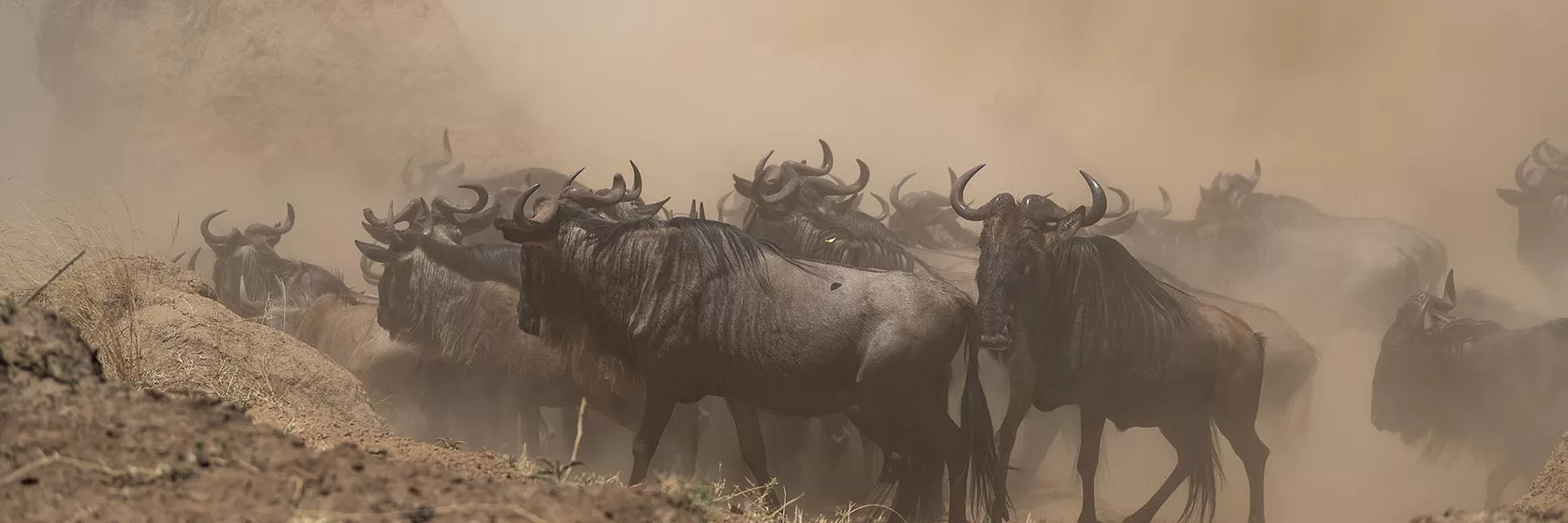Introduction
The Great Migration, often referred to as ‘the greatest show on Earth’, is a once-in-a-lifetime spectacle and the greatest natural wonder on this planet. The phenomenon has been on every safari enthusiast’s bucket list and others alike. It is one of the most celebrated experiences when massive herds of animals across East Africa participate in an annual migration.

Annual cycle of migration
East Africa’s great migration is the largest terrestrial mammal migration in the world. The event looks straight out of a movie, and people usually expect scenes where herds move together or get taken down by predators. But a great migration is much more than a grand scene.
This emotional experience covers the wonders of nature that cannot be captured in videos or images. The Great Migration showcases the circle of life in the endless landscapes of Africa. The journey involves surviving the deadliest predators as well as keeping the classic annual migration alive.
What is the Great Migration?
The incredible expedition involves around 1.2 million wildebeest, 400,000 zebras, gazelles, antelopes, and topi migrating together in the Serengeti-Mara ecosystem. The long trek commences in the North of Tanzania’s Serengeti National Park and ends at Kenya’s important reserve, the Masai Mara.

Talek river from top
The herd is guided by survival instinct, and each wildebeest covers approximately 800–1000 km on its journey. It is also one of the most difficult tests for these animals, as predators are always ready to pounce on them during the trek. While on land, lions, leopards, cheetahs, hyenas, and wild dogs follow the herd to take down prey.
The river crossing, which is part of the journey, witnesses deadly crocodiles lurking in the waters to kill these animals. It is reported that annually, an estimated 250,000 wildebeest and at least 30,000 zebras die during the great migration as a result of disease, starvation, or becoming food for predators.

An eventful day is about to begin
Along with adult wildebeest, their younger calves also undertake the journey. This attracts predators increasingly, as the young are vulnerable, weak, and easy targets.
What primarily triggers the herd to start moving is the onset of rain. It remains unclear how wildebeest decide which direction they are supposed to go. Yet, some experts conclude that animals react to the lighting, thunderstorms, and rainfall over 50 kilometres away.
This continuous and year-long journey spans around 1200 miles. The two countries play different roles from season to season. The events that unfold during the fluid migration include mating rituals, calving, and herd behaviour, which are largely influenced by subtle changes in rainfall every year.
Why does this phenomenon occur?
The Great Migration occurs for a simple reason: food and water. The herds plan their annual trip across the Serengeti and Mara plains to search for nutrition as the land dries up in certain seasons.
The wildebeests embark on their journey and spend most of their time in the Southern Plains of the Serengeti. This area has lush grass, which is the main reason why animals congregate to give birth. But when the grass and water in the Southern Plains start to dwindle, the herds begin to head north across the Western Section. This area is also referred to as the Western Corridor of the Serengeti.
The herds enter the Masai Mara in Kenya during the latter part of the year. They spend about two months in the Mara. When the Southern Plains of the Serengeti become fertile again, the herd heads south.
During their expedition in the Serengeti and Masai Mara, the animals have to cross rivers to continue their journey. In the Serengeti, the Grumeti River has Africa’s largest crocodiles, which makes the crossing a dramatic scene. Similarly, one can witness a spectacular river crossing on the Mara River in the Masai Mara.

Crossing on Olare Orok river
The Great Migration: A timeline
The Wildebeest migration depends largely on the availability of food and water. Moreover, as climate change is on the rise, the short and long rains in Tanzania and Kenya make the sightings less predictable.
As the rains can occur late or early, it usually makes the migration calendar out of synch. This is why visitors are expected to plan a safari trip for an extended period as opposed to just 2–3 days.
According to the months, here is a general outline of what events unfold in the Great Wildebeest Migration:
January
In January, the Serengeti National Park in Tanzania observed herds moving South near the area of Lake Ndutu. However, the two million wildebeest, zebras, and gazelles are not in a single herd. Although they are part of the Great Migration, they separate themselves into megaherds of hundreds to thousands in a group.
February to March
These months mark the calving season, when female wildebeests can give birth to 8,000 wildebeest calves in a day. The younger ones start learning survival skills from adults, which marks the start of the migration journey. However, the calves can, unfortunately, become prey for hungry predators as well.
Visitors may have the opportunity to see dramatic chases as the circle of life is portrayed in real time. It is the lion pride that usually hunts down the calves, but spectacles of leopards, cheetahs, jackals, hyena clans, and even wild dogs chasing them can be seen.

A herd chased by Cheetah
As the rains begin in March, the animals stop grazing across the Serengeti’s short plains and start to move towards the West.
April-May
The long rains occur in April and May, when heavy flooding makes it harder to spot the herds at this stage of migration. Nevertheless, the animals generally move towards the Simba Kopjes and Moru in a north-westerly direction. This is also the breeding season, where male wildebeests compete fiercely over mates.
In May, the herds reach the Central Serengeti and pick up the pace as the calves become stronger.
June-Mid July
The animals are on the move through the Seronera Valley in May and into the Western Corridor in these months. A large number of Wildebeest now have to go through the toughest stage of their journey: crossing the Grumeti River. The herds congregate and attempt to cross the river while avoiding the Nile crocodiles.
These months also observe the mating season. Wildebeest, zebras, and other animals start heading north as they follow the thunderstorms.
Late July-October
During these months, the herd typically crosses the northern border of Serengeti National Park and enters the Masai Mara in Kenya. Here lies another obstacle in their trek, which is more dangerous than the Grumeti crossing. The Mara River is infested with crocodiles and often showcases dramatic killings.

Cub caught by Leopard
This is a spectacular sight, but it also presents the reality of nature. It is because wildebeests and other animals that make it so far in the journey can perish due to injury or predation.
If animals are successful in surviving the crossing, what lies ahead for them is ample green grazing opportunities. The north is a beautiful area where one can spot other diverse wildlife as well.
November- December
November and December observe short rains, which fill the Mara with a green and luscious landscape. The herds become dispersed in large groups around various areas like the Southern Plains, Ndutu, Ngorongoro, and Loliondo.
However, once the herds finish relishing the Masai Mara’s grassland, they head back to the Serengeti, which has rejuvenated once again. As the rains can be unpredictable in December, wildebeest, zebras, gazelles, and others may also start moving to the South.
Those who have survived will give birth during the calving season in January and start the death-defying journey all over again.

Great river crossing
Where should you see the Great Migration: Masai Mara vs Serengeti?
Herds of wildebeest pass both the Masai Mara and Serengeti annually. Thus, visitors assume that Kenya and Tanzania are both go-to destinations. However, each place brings unique experiences of migration.
Serengeti National Park
The Serengeti National Park in Tanzania is not as accessible as the Masai Mara. During heavy rains, the park can get flooded and roads become impassable, which makes it difficult to spot the herds. However, the park is ideal for safari enthusiasts willing to undertake a genuine camping trip.
Another positive feature of the Serengeti is that, due to its isolated nature, the park sees fewer tourists and has a quieter atmosphere. Watching events such as river crossings or migration sightings becomes an intimate experience as you share the sighting with only a few people.

Lone cub trapped between two lionesses
Masai Mara
On the other hand, the Masai Mara in Kenya remains the top destination for migration. Here, one has a better chance of seeing the migration and the Mara River crossing, as the route in this reserve is much more concentrated. Moreover, the Masai Mara is easily accessible from Nairobi. The reserve is the main hotspot for the big five as well as other animals like rhinos, elephants, giraffes, and many more.

Zebra cub trapped by crocodiles
The Mara River crossing
The Mara River crossing is one of the highlights for visitors to witness. There is no exaggeration when it is said that the event appears similar to a film and seems surreal.
The Mara River lies between the borders of Tanzania and Kenya. For the wildebeest and other animals accompanying them, it serves as an essential point to cross. As crocodiles lie in the waters completely hidden, the anticipation is very high. When the animals jump into the river to make it to the other side, many of them may end up being prey to crocodiles.
Although August to October predict the period when the Mara River crossing takes place, there is a probability one might not end up seeing it.
The wildebeest are aware of the deadly predators that lie beneath the surface of the river. So, they might end up standing near the banks of the river for days. They also wait for one of the wildebeest to take the leap before following the lead. Or, abandon this crossing altogether and look for another point to traverse.
But this does not mean there are zero chances to witness this spectacular event. With a professional and local guide, you can watch the Mara crossing before crowds of tourists start to gather.

Another day, another crossing
When is the best time to see the Great Migration?
You can plan your safari trip according to the migration movement, as this phenomenon is a year-round, circular journey. Furthermore, as the seasons are dynamic, they can affect the movement of the great migration.
The peak season for the great migration is July to October, including the river crossing. During these months, you have the chance of seeing herds entering the Masai Mara from Serengeti National Park.

Herds about to cross
How to enjoy the Great Migration experience to the fullest?
The Great Migration Safari trip is always surrounded by unpredictability. To maximise your migration experience, here are some of the tips that are beneficial while planning:
- Always book a reliable tour operator who has a ground presence in Kenya, like Wild Voyager, as they are well-equipped with the herd’s movements. Moreover, they also know the best time and spot to catch the Mara crossing.
- The safari’s high or peak season is from June to October. Needless to say, the camps and lodges are filled quickly. It is better to book in advance, at least 8 months or a year beforehand, so that you secure the best lodges in a desirable location.
- Think carefully while planning your safari trip, as the Great Migration largely depends on seasonality. Choose and arrange your trip according to what you want to experience and see.
- Many times, the Great Migration experience can become noisy and busy. Select camps and lodges that offer other diverse wildlife viewings as well, such as the big five, elephants, giraffes, leopards, and more.
- For the best migration experience, you can combine both Masai Mara and Serengeti together. Places like Amboseli, Ngorongoro Crater, Laikipia, Rift Valley, and Tarangire can be added to the parks.
Have a look at this 60s explainer video, which explains the great migration with very simple infographics.
If you loved reading this story, then subscribe to our blog here (it will ask to verify your email) to get inspiring travel stories and trivia delivered to your email. Stories about wildlife trivia, cultural experiences, curated luxury hotel lists, underrated places to travel, polar journeys and much more.











